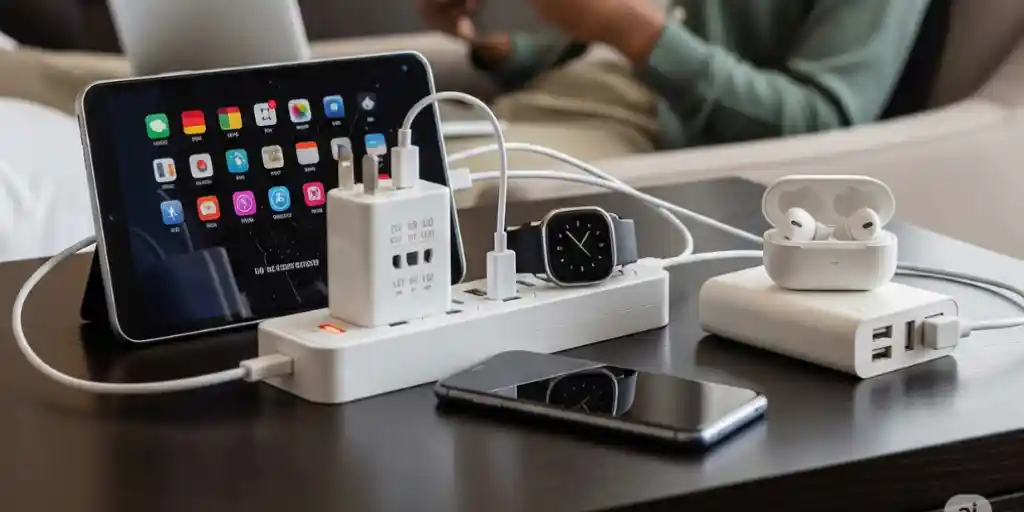Ever found yourself in a hotel room, airport, or shared space with only one power outlet—but multiple devices dying fast? In today’s digital world, from phones to tablets, headphones to power banks, we need to stay charged 24/7. The good news? You can power everything from a single socket—safely and efficiently—with the right tools.
In this blog, we’ll reveal the common mistakes people make while multi-charging and share smart hacks to safely power all your devices from just one plug. From adapters to power strips to USB hubs, we’ll break it down in simple terms and help you stay fully charged anywhere, anytime.
🔍 What Happens When You Overload One Outlet?
Plugging too many devices into one socket without planning can result in:
-
Circuit overloads and tripped breakers
-
Device overheating or charging failure
-
Slow charging due to underpowered outlets
-
Fire hazards with low-quality gear
But with modern tech, you don’t need to risk any of this.
💡 Why This Problem Exists
Most hotel rooms, dorms, airports, or cafes offer limited outlets. Meanwhile, people carry:
-
Phones, smartwatches, tablets, laptops, power banks, earbuds
-
Different charging protocols (USB-A, USB-C, PD, QC, etc.)
-
Multiple brands with different power needs
So yes—without a strategy, one plug isn’t enough.
✈️ Common Multi-Charging Problems from One Plug
| Scenario | Charging Issue | Typical Result |
| Plugging in multiple chargers | Overload or fire hazard | Circuit trips or devices heat up |
| Using basic power strips | No surge protection or fast charging | Devices charge slowly or inconsistently |
| Sharing USB ports at airport | Insecure power source | Risk of data theft or slow power |
| Using one cable for all devices | Incompatible voltage or amp needs | One or more devices fail to charge |
🛡️ Top Power Plug Tricks to Charge All Devices Safely
Let’s explore proven tricks that travelers, students, remote workers, and techies use to get the most from a single outlet—without frying a fuse.
1. ✅ Use a Surge-Protected Multi-Port Charger
Why it matters: Not all multi-chargers are created equal.
Power Plug Hack:
-
Get a charger with at least 3–6 USB ports + surge protection.
-
Look for brands like Anker, UGREEN, Belkin, or Baseus.
2. 🔌 Pick a Power Strip with Both AC + USB Ports
Problem: Traditional power strips only offer outlets—not USB.
Why it’s limiting:
-
You still need multiple bricks (chargers).
-
USB devices won’t charge directly.
Power Plug Trick:
-
Choose modern power strips with 2–4 AC plugs + 3–5 USB ports.
-
Check for USB-C + PD (Power Delivery) support for faster charging.
3. ⚡ Prioritize High-Wattage Chargers
Why it matters: Charging multiple devices needs enough total output.
Power Hack:
-
Look for chargers offering 60W–100W total output.
-
Distribute load: High watt ports for laptops/tablets, low for phones.
4. 🔋 Use Smart Charging Hubs with Power Distribution
Problem: Basic splitters charge one device faster, others slower.
Why it’s inefficient:
-
Uneven charging = wasted time + risk of battery stress.
Power Plug Trick:
-
Use intelligent power hubs that auto-distribute current.
-
Many support Qualcomm QuickCharge or USB-PD protocols.
5. 🧳 Travel with a Universal Power Adapter
Why it matters: One outlet in another country may not fit your plug.
Travel Hack:
-
Use all-in-one adapters with USB ports + universal plug conversion.
-
Great for EU, UK, Asia, and US trips.
6. 🔐 Avoid Public USB Charging Ports
Problem: USB ports in airports or hotels can be hacked.
Why it’s risky:
-
Juice-jacking can steal your data.
-
Power may be limited or unstable.
Power Plug Trick:
-
Carry a “USB data blocker” dongle.
-
Or better: Always use your own brick charger.
7. 📱 Use Short, High-Quality Cables
Why it matters: Long or cheap cables lose power during transfer.
Power Hack:
-
Use braided or reinforced cables under 3 feet for faster charging.
-
Look for MFi-certified (Apple) or USB-IF certified cables.
💳 Best Power Products to Use in 2025
| Device/Brand | Ports | Total Power Output | Price Range |
| Anker 747 GaNPrime | 4 (USB-C + A) | 100W | $90–$110 |
| UGREEN 65W Charging Strip | 3 AC + 3 USB | 65W | $40–$60 |
| Baseus 6-in-1 Travel Hub | 2 AC + 4 USB | 60W | $35–$50 |
| Belkin BoostCharge Pro | 4 USB ports | 108W | $80–$100 |
🔍 Real User Example
“I travel with one Anker 100W charger that powers my MacBook, iPhone, AirPods, and Kindle—all at once. It’s compact, fast, and keeps my backpack light.” – Rahul, Digital Nomad
🧠 Pro Tips to Remember
-
Always check wattage before plugging multiple devices
-
Use chargers with USB-C PD for laptops and tablets
-
Avoid daisy-chaining multiple power strips
-
Never use off-brand power products with poor reviews
-
Label your cables to avoid confusion while traveling
💬 Final Thoughts: One Plug, Full Power
You don’t need five chargers and ten cables to stay powered. With smart planning and the right tools, one outlet can handle your full digital life.
✅ Don’t just plug in—plug in smart.
✅ Don’t just charge—charge efficiently.
✅ Don’t just power up—power up safely.
These plug tricks can save space, time, and prevent damage—no electrician required.
📌 FAQs About Charging Multiple Devices
Q1. Is it safe to charge many devices from one outlet?
Yes—if you use quality surge-protected hubs or strips designed for multi-charging.
Q2. What’s better: power strip or charging hub?
Use both—a hub for USB charging, and a strip for bigger devices like laptops.
Q3. Can one plug charge a laptop and phone together?
Yes—if your charger supports USB-C PD and has enough wattage.
Q4. Are cheap multi-port chargers okay?
Avoid unbranded ones. Stick to trusted names to avoid fire or device damage.
